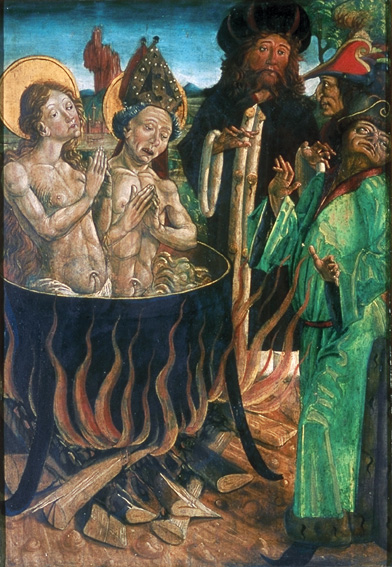The story of these two saints is told in the Golden Legend. Using his evil arts Cyprian enlisted a demon in his designs on the virtue of the Christian Justina. The demon kept trying, but every attempt failed when Justina would make the sign of the Cross. The devil had to admit to Cyprian that "the crucified God" was stronger than he, so Cyprian renounced his relationship with the devil and became a Christian himself. Eventually he was made the bishop of Antioch.
Later Cyprian and Justina came to the attention of the "earl of that country" (so Caxton; comes or "count" in the Latin sources; "prefect" in Ryan). He had them taken before him in shackles, beaten, scourged, and cast into a great cauldron of boiling pitch, wax, and tallow. When all this did not persuade them to return to the worship of the gods, they were beheaded. Their bodies were thrown to the dogs, although soon thereafter some Christian sailors took them to Rome for a proper interment.
Sometimes artists seem to confuse this St. Justina with Justina of Padua. For example, this statue's left hand holds a demon, apparently referring to the one in Justina of Antioch's story. But in the right hand is a sword, an attribute of the Paduan saint.
Prepared in 2017 by Richard Stracke, Emeritus Professor of English, Augusta University

A western painting of the martyrdom of Justina and Cyprian, probably 18th century (See the description page)
Orthodox icon of the two saints (See the description page)
DATES
- Feast day (for both): September 26
- The martyrology cited above and a vita in the Acta Sanctorum say the Emperor at the time of these saints' martyrdom was Diocletian (284-305).
NAMES
- This St. Cyprian is not to be confused with the Cyprian invoked in the Roman Canon. The latter is St. Cyprian of Carthage.
BIOGRAPHY
- Golden Legend #142: html or pdf.
- John the Stylite, "Cyprian and Justa," in Select Narratives, 185-203.
- Roman Breviary (in English), IV, 587-88. (1632 Latin text: 1046.)
- Acta Sanctorum, September vol. 7, 195-246.
ALSO SEE